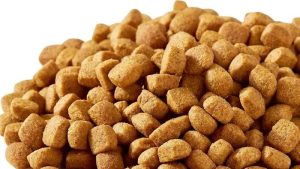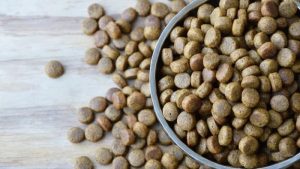As a new puppy parent, it’s only natural to want to provide the best possible care for your furry friend. With so many options available, it’s easy to get overwhelmed, especially when it comes to choosing the right food. Some pet owners consider feeding their puppies adult dog food to save money, but is this the right choice? Can a Puppy Eat Adult Dog Food?
In this blog, we’ll explore the differences between puppy food and adult dog food and help you understand why it’s important to provide your puppy with the right nutrition. So, let’s get started and learn all about feeding your new best friend!

Can a Puppy Eat Adult Dog Food?
No, puppies should not eat adult dog food, due to their different nutritional needs. A puppy’s body is already undergoing the growth stage and they require more minerals and nutrients to grow and develop. The adult dog has already developed strength and muscles, so their food might not be heavily nutritive.
Puppies require more fat, calories, protein and calcium for their overall development[1]. Adult dog food cannot provide the puppy this much-needed minerals and nutrients and thus should not be fed.
If you feed your puppy an adult dog then it won’t necessarily harm them but will surely keep them deprived of nutrients. This lack of nutrients will make the puppy weak and act as a hindrance to their overall development. Moreover, it can lead to deficiencies in puppies.
There are some dog food which is specially designed for both puppies and dogs. To know this check the label while buying the food, if it mentions, “All Life Stage” then you can feed your adult dog and puppy both the same food.
Different Nutritional Needs of Puppy & Adult Dog
The reason that puppies and adults have different nutritional needs is that they have important differences between them. They work differently, so they need different types of nutrients.
Puppies tend to grow rapidly, dogs usually complete their growth in the first two or three years of life. This growth requires different resources. Specifically, it means that puppies require more amino acids (the building blocks of proteins), and therefore tissues than adults do.
Why Cannot Adult Food Be Served to Puppies?

Adult dog food has less protein, calories, and fats when compared to the diet of a puppy as it needs such nutrients for body growth, which at this point is not required by an adult dog. However, once a puppy grows, the owner should avoid giving foods with high protein and fats; as it can make the dog overweight.
For example, “The Association of American Feed Control Officials (AAFCO) recommends that puppy foods (food for growth and reproduction) contain a minimum of 22.5% protein, while adult dog foods (adult maintenance) only need to have 18%. The AAFCO also recommends that puppy foods contain a minimum of 8.5% fat and 1.2% calcium, while dog foods should have only a minimum of 5.5% fat and 0.5% calcium.”
Some owners choose to feed a raw food diet. This involves providing raw meat, bones, and vegetables. Check our guide on, "how to switch to raw dog food" for more details.
What Can Puppies Actually Eat?
The Association of American Feed Control Officials (AAFCO) establishes dog food guidelines, and in order for a portion of dog food to be sold in stores as “complete and balanced,”[2] it must meet AAFCO’s nutritional profile standards.
There are two dog food nutrient profiles that you should be aware of when choosing food for your puppy. One is “growth and reproduction” (which is the designation for a food formulated for puppies and pregnant or nursing dogs).
The other is “adult maintenance” (which means that it’s formulated for adult dogs). Look at the label to ensure that you are buying food that is right for your dog’s life stage.
When choosing the best dry dog food for your puppy, look at the label to ensure you are buying food formulated for your puppy's life stage.
How to Transition Your Puppy to Adult Dog Food?

Here are some tips you can follow for transitioning your puppy to adult dog food:
- Before transitioning your puppy to adult food it is very important to consult a vet. The vet according to your dog’s nutritional requirements and activity will suggest which dog food to choose.
- While switching to dog food make sure you read the label and check the nutritional content of the food. You should always opt for completely balanced dog food and to know it you can check the AAFCO statement.
- At the time of switching to adult dog food, do not do it instantly. Gradually introduce a new food, for instance, start by mixing a small amount of adult dog food with your puppy’s ongoing food. Slowly increase the quantity this will make the dog’s digestive tract habitual to the new food.
- Keep checking on your dog, to know if the new food suits them or not, if they show symptoms like diarrhoea, weight loss, or vomiting then consult a vet.
FAQs
1. When to switch from puppy food to adult food?
Most dogs change their diet between the age of 18-24 months. However, this date varies for each and every dog, you must consult your vet before making such a change.
2. What are the components of good puppy food?
Good puppy food contains high calories, ample protein, and essential minerals and vitamins to support growth and health. Adult dog food may not have the proper balance of these nutrients and can hinder a puppy’s development, so it’s important to choose quality puppy food.
3. Can dog food make a puppy sick?
No, there is very less chance that your puppy might fall as it is ‘dog food’ only.
4. Can adult dogs eat puppy food?
Yes, they can, but it will not lead to any specific health benefits. As adult dogs do not require much fat and calories. Eating puppy food may rather make them more obese. However, extremely active dogs can handle such high caloric values of puppy food.
The Bottom Line
‘You should feed puppy food to puppies and feed adult food to adult dogs.’ Both types of food are made after effective consideration and should be followed as such. Along with providing your puppy with the proper nourishment, exercise and mental stimulation are equally crucial.
If your dog is older, seek foods that support healthy bones and joints; for puppies, locate foods that support the development of their bones, joints, and muscles. It all depends on where your dog is at the moment.
If you wonder why is my dog not eating his food anymore, it could mean it's time to transition to a different dog food formula suitable for his current life stage.
References:
- Mansourian, E. (2022, March 21). Puppy Feeding Fundamentals. American Kennel Club.
- Center for Veterinary Medicine. (2020, February 28). “Complete and Balanced” Pet Food. U.S. Food And Drug Administration.



